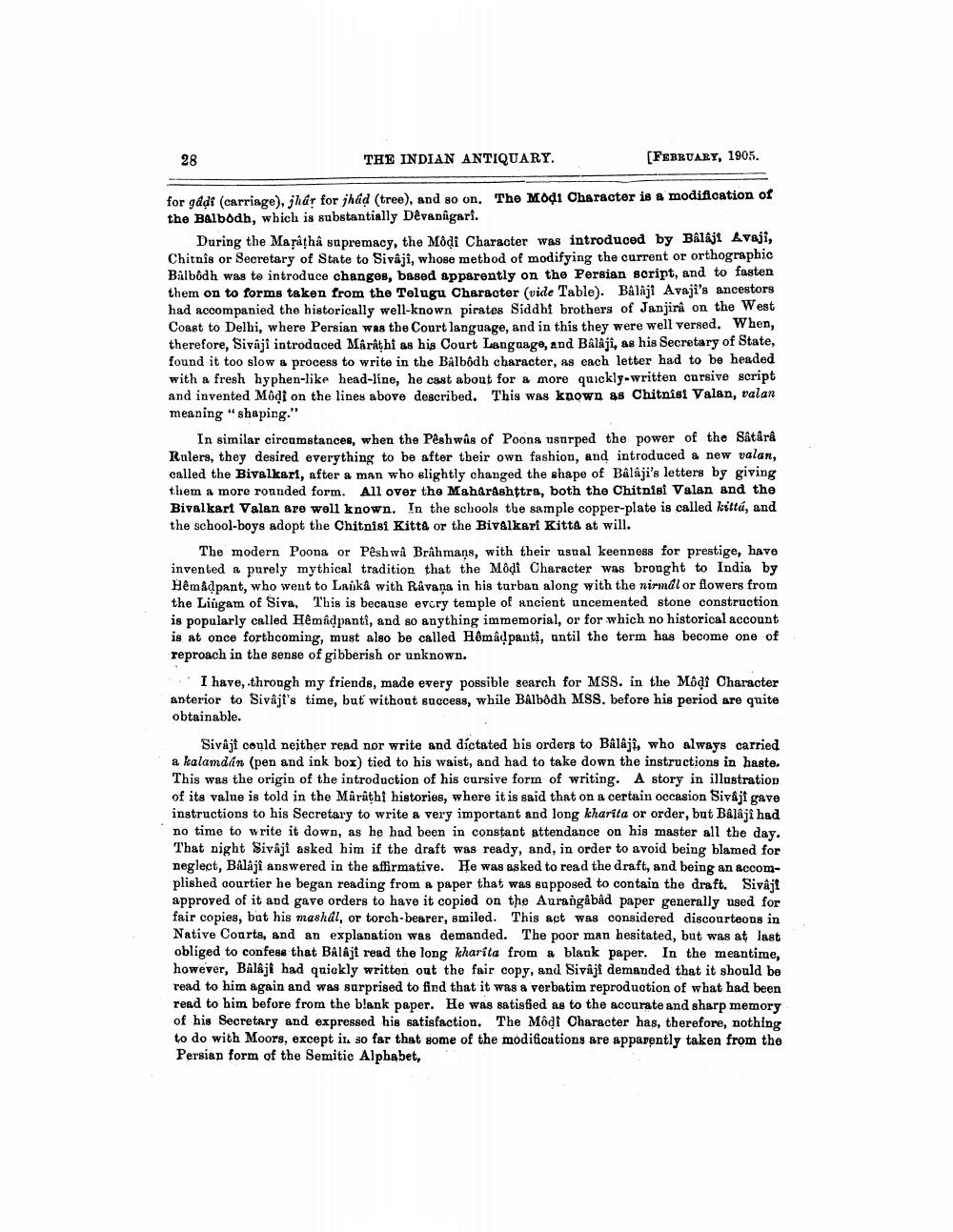________________
28
THE INDIAN ANTIQUARY.
(FEBRUARY, 1905.
for gadi (carriage), jhár for jhad (tree), and so on. The Moi Character is a modification of the Balbodh, which is substantially Dêvanîgari.
During the Maratha supremacy, the Modi Character was introduced by Balajt Avaji, Chitnis or Secretary of State to Sivaji, whose method of modifying the current or orthographic Balbôdh was to introduce changes, based apparently on the Persian script, and to fasten them on to forms taken from the Telugu Character (vide Table). Balaji Avaji's ancestors had accompanied the historically well-known pirates Siddhi brothers of Janjirâ on the West Coast to Delhi, where Persian was the Court language, and in this they were well versed. When, therefore, Sivaji introduced Marathi as his Court Language, and Balaji, as his Secretary of State, found it too slow & process to write in the Balbodh character, as each letter had to be headed with a fresh hyphen-like head-line, he cast about for a more quickly written cursive script and invented Modi on the lines above described. This was known as Chitnisi Valan, valan meaning "shaping."
In similar circumstances, when the Peshwas of Poona usurped the power of the Sâtårå Rulers, they desired everything to be after their own fashion, and introduced a new valan, called the Bivalkart, after a man who slightly changed the shape of Balaji's letters by giving them a more rounded form. All over the Maharashtra, both the Chitnisi Valan and the Bivalkart Valan are well known. In the schools the sample copper-plate is called kittá, and the school-boys adopt the Chitnisi Kitta or the Bivalkari Kitta at will.
The modern Poona or Pêshwa Brâhmans, with their usual keenness for prestige, have invented a purely mythical tradition that the Môdi Character was brought to India by Hêmådpant, who went to Lajka with Ravana in his turban along with the nirmdl or flowers from the Lingam of Siva, This is because evcry temple of ancient uncemented stone construction is popularly called Hêmadpanti, and so anything immemorial, or for which no historical account is at once forthcoming, must also be called Hômad panti, until the term has become one of reproach in the sense of gibberish or unknown.
I have, through my friends, made every possible search for MSS. in the Modi Character anterior to Sivaji's time, but without success, while BAlbodh MSS. before his period are quite obtainable.
Sivaji could neither read nor write and díctated his orders to Balaji, who always carried a kalamdan (pen and ink box) tied to his waist, and had to take down the instructions in haste. This was the origin of the introduction of his cursive form of writing. A story in illustration of its value is told in the Marathi histories, where it is said that on a certain occasion Sivaji gave instructions to his Secretary to write a very important and long kharita or order, but Balaji had no time to write it down, as he had been in constant attendance on his master all the day.
That night Sivaji asked him if the draft was ready, and, in order to avoid being blamed for neglect, Balaji answered in the affirmative. He was asked to read the draft, and being an accomplished courtier he began reading from a paper that was supposed to contain the draft. Sivajt approved of it and gave orders to have it copied on the Aurangabad paper generally used for fair copies, but his mashal, or torch-bearer, smiled. This act was considered discourteons in Native Courts, and an explanation was demanded. The poor man hesitated, but was at last obliged to confess that Balaji read the long kharita from a blank paper. In the meantime, however, Bâlâji had quickly written out the fair copy, and Sivaji demanded that it should be read to him again and was surprised to find that it was a verbatim reproduction of what had been read to him before from the blank paper. He was satisfied as to the accurate and sharp memory of his Secretary and expressed his satisfaction. The Môdi Character has, therefore, nothing to do with Moors, except in so far that some of the modifications are apparently taken from the Persiap form of the Semitic Alphabet,




